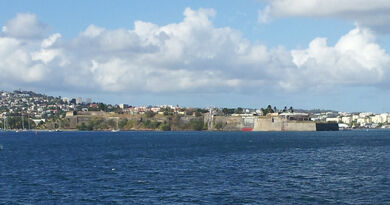Carnival sources and traces
Oh madiana jou a ka ouvè ladjé mwen…..!
Ah ! CE CARNAVAL MES AMIS ……!
From what period in the history of Martinique did the carnival become a real social entity, element of identity, culture and heritage? What could be the facets of this demonstration before 1848? Apart from multiple assumptions and fleeting traces, the archives are still silent, suffering from the quest of historians. However, one can imagine that this cultural element is under construction through the cultural contributions of the various components of society, social and racial segregation and the fact of slavery.
From the first years of colonization, “celebration” was present in the colony, notably religious festivals. The Martinique Code attests to this and the colonial authorities did not hesitate to take police measures to ensure public order. Police officers must ensure that there is no disorder in the cabarets. For the period 1642-1804, the Code does not provide any information on the Carnival. However, through our archival peregrinations we keep the memory of a reference to the “Lupercanes” festivals celebrated in Rome, on February 15 in honor of Lupercus, God wolf killer. Pope Gelasius 1 definitively condemned the feast in 494. “The luperques dressed in the skins of immolated beasts, engaged in a race during which they struck with thongs of skin the crowd and preferably the women to ensure their fertility” (G. L). The Gazettes de la Martinique for the years 1788 and 1790 are hardly more generous. With the abolition of slavery (1848), society was structured on the foundations of “freedom” and no doubt carnival emerged as a visible entity in the multicultural expression of this colonial society. In the second half of the 19th century, we surreptitiously saw traces of this cultural, social and living expression. But, we would like to be able to date the arrival or the emergence of our most famous carnival characters.
The table in the Official Bulletin of Martinique (BOM) of 1828-1837 mentions various decisions in 1831 concerning the offenses of the defense of masking and disguising oneself during carnival. The Bulletin of the administrative acts of Martinique of 1831 explicitly refers to the existence of the Carnival. By decision of February 7, 1831, Governor Dupotet prohibited to hide or disguise himself during the carnival. Individuals who contravene this decision would be brought before the ordinary police courts and punished in accordance with the provisions of book 4 of the penal code, imprisonment for 5 to 15 days and a fine of 61 to 100 francs. The purpose of this ban was to prevent unrest and disorder. The BOM of 1837 specified that the measure applied to any person of any class and condition during the duration of the carnival. We thus find various decrees prohibiting masking from 1838 to 1850 (BOM tables). In 1838, Governor Rostoland justified this ban in order to prevent disturbances and disorders to which masquerades and disguises (BOM) may give rise. In 1841, the use of the mask during carnival was prohibited. It is clear that this provision will be imposed from 1828 to 1850. This ban only expressed one of the facets of this carnival.
Thus, Cassagnac in “Voyage to the Antilles” depicts in 1842 an astonishing ball of domestic Negro slaves at Fort Royal, on Fat Sunday. It was a ball of rich clothing and surprising jewelry. The orchestra of white soldiers had been paid for by slaves. Roseval also evokes in 1842 the passion of the negroes for the dance and in particular the negro ball around the drum: “we pass successively from Bel-Air to Chika, to Calenda and finally to Bamboula”. Cassagnac also indulges in an interesting description of the “drum orchestra” of the negroes. This one joins that of Henri Monet who perhaps offers us a track on the roots of our video. This in his work La Martinique refers in 1891 to the video he defines as “intimate national dance. Something that resembles cachuca, cancan, farandole and heckling ”, a“ mad desire for hustle and bustle, destruction, bamboo; the emptied! … it is the cyclone of the dance ». The video Monet portrayed us was initially structured around the “Bel Air drum”.
In the last decades of the 19th century, evidence of the growing fervor of carnival expression multiplied. Thus in the newspaper La Défense Coloniale of February 13, 1884, an advertisement invites “the grand ball dressed up and masked”, probably at the theater of Saint-Pierre. In addition, the Official Bulletin of Martinique of 1893 mentions the decision to close offices, construction sites and government workshops from Tuesday to Ash Wednesday at 2 am. Lafcadio Hearn in his work Two years in the French West Indies in 1890 devotes a chapter to the place of “guiablesse, worry and zombie” in West Indian popular culture.
Louis Garaud, in his work Three years in Martinique, published in 1895, also evokes the Carnival of Saint-Pierre which started on the day of kings, every Sunday. He describes the “People’s Carnival” very different from anything he had seen elsewhere. The whole city (Saint-Pierre) sang, danced, waved “its bells”. He evokes the “waves of street kids in rags, the horned devil, the crowd of men and women behind a few Negro musicians”. During this entire carnival period, the author noted no brawl. In 1898, a decision fixed the holidays of the fat days. This arrangement was found in the following years until 1907. From the end of the 19th century, the historical traces of our carnival are more and more numerous. Curiously, while the written press remains “very reserved” on the reporting and expression of this event, it is the photography that brings us tangible and strong light. The exhibition of the Regional Museum of History and Ethnography in March 2007 In Carnival Fever, presented precious photographs of the carnival of Saint-Pierre before 1902. On a photograph of “one day of Carnival” in Saint -Pierre before 1902 one discovers there an impressive vide of “touloulous” with orchestra on foot offering a popular ball. This disguise which seems so original in 2007 was legion at the end of the 19th century. On another photo of a Fat Tuesday at Fénelon square at the beginning of the 2nd century, we can see a devil on stilts, “Mariannes Lapo fig”, “Carolines”.
Finally, on another iconography dating from 1960 and concerning Mardi Gras, we can see that the devil’s costume with horns and tail dressed the empties. If we rediscover more than a century after the photographs of our carnival, our knowledge of this social expression dates from the first half of the 20th century, through literary works and testimonies. These can be classified into two categories, on the one hand, witness and narrative works of the social fact, and on the other, those which extrapolate. C. Crabot and J. Delaplace, in Le guide de la Martinique wrote in 1960 that carnival was a period offering a veritable festival of Martinican folklore.
In his book Enchantement des Antilles, Le Rumeur proceeds to a description of the picturesque characters and scenes of the Fort-de-France carnival around the 1960s. A scene illustrated by a beautiful photograph of a parade of imps, on mardi gras, behind an orchestra installed on a convertible “Sedan”. We can see two “devils” in white pole. In another photo is immortalized “the hospital chariot” with a group in a white long-sleeved nightgown, wearing a white mask and a very tall white cap, pointed in the shape of a pistachio horn. The Rumor also shows us a group of women devils making “the chain” in the respect of colors (black and white). Traditional costume was omnipresent. The author also proceeds to a description of the carnival journey of the time. He underlines the importance of dancing and other parties. In 1963, the carnival party went from Saturday to Ash Wednesday. The Rumor signals men disguised as women, an inverted woman-man couple. One day he evokes messy people, that is to say reserved for people who are badly dressed. The author also noted “the dance of a sort of savage with an anteater nose, in thick clothes in dry banana leaves with an elegant black with grape lips, in sport shoes and sky blue dress”. Other terrifying people, two strange devils escorted by tom-toms who recalled the images of witches or witch doctors “which illustrate the books of those who explored dark Africa”. They wore a fantastic hairstyle, a red dress, a green face. The hideous “red devils” were also present with large oxen horns on which mirrors hung. They had a large red tail. The horror of these devils was second to none. At the time, the fat days were an opportunity for women to “dress up” with the Creole costume in all its facets with its procession of jewelry. Women treasured these outfits. The traditional costume was thus omnipresent. The Rumor also expressed its astonishment at the intensity of Ash Wednesday, an “apotheosis of mourning, unique in the world”. A strange, burlesque, implausible, unexpected mourning. They all shared this mourning in joyful and shocking music. Everything was white or black. Rumor noted that there was no longer any social class. It was a river of devils or giablesses. They sang “vaval ka kité nou” or “stolen butterfly”. There was also a parade of cars. At the time, there was a popular ball on the savannah and “slave dances” on the levee: “ting cang, kalenda, beautiful air, high waist, negro quadrille”. The carnival was also an opportunity for laghia events. Vaval, a character in popular mockery and his cremation, was already present.
From its creation in 1964, the France-Antilles newspaper of January 18, 1965 covered the carnival reality and titled “mammaille-là, moin vini oué zot: Bienvenue à Vaval!” With a photograph of imps. This year 1965 Vaval had taken the appearance of a horned devil. A crowd of all fairly dense pageantry accompanied him. Cowboys, Indians, pierrots and stones, madras and boater colored the event. The newspaper (F.A) already offered beautiful photos. For 15 Francs, you could dance at the big masked and transvestite ball organized by the carnival coordination committee and the Jallier group. The music was provided by Barrel Coppet and Al Lirvat. Hortense Edragas in traditional costume was the queen of this year’s carnival. The Carnival of the schools shone in the streets of Fort-de-France and in Trois-ilets. The Creole song contest was enriched by this gentle rivalry between Guadeloupe and Martinique. That year, Maurice Champvert was the winner. The fear of our carnival dying accompanied this living social expression throughout the 20th century. The destruction of the City of Saint-Pierre will cause a period of latency and resurgence in order to bring about the emergence of a carnival in constant evolution or transformation throughout the 20th century. The idea of a Carnival Museum is not without interest because this event is above all the expression of a society at a given time. Admittedly, a touloulou and a marianne with fig skin can always resurface, but new characters appear, evaporate or persist. The structure of the empties and the carnivalesque technical means have changed in half a century. The development of the media and the means of communication now favor an accumulation of archival sources. The 1997 France-Antilles newspaper revealed the popular “frenzy” and the social and cultural dimension of this heritage. Admittedly, there was a temporary loss in the originality of the disguises and in the safeguarding of the traditional disguise, but on the other hand, some were working on the rehabilitation of the emblematic values of the carnival (mas an mô, neg gwo- siwo … etc.). Carnival thus allows everyone their own freedom of expression. The elections of queens and mini-queens occupied an important place in the carnival mobilization of the communes. Musical expression is now plural (on-board orchestras, super powerful sound systems, orchestras on foot with “drums”, etc.). The France-Antilles newspaper also makes it possible to perceive the problems of functioning of carnival associations (OMDAC, the Foyal carnival committee, FECAMA, … etc).
In a century the carnival was structured and continued its geographical deployment (parade from the north, from the south … etc). The carnival of children and schools now appears as “fireworks” of the cultural heritages of the world, of colors, of costumes. It is now a driving force for sustainability and is part of an anthology of expressions and carnival events very different from each other (contest of the Creole song and the best video, emptied in pajamas at dawn on Good Monday, evenings dancing, etc.).
The various media of the second half of the twentieth century offer us a profusion of photos, written and visual reports, the music of videos and dance evenings. They also allow you to soak up the social and political climate. In 1997, we were talking about mad cows. At the dawn of the 21st century, this cultural and social event will undoubtedly never have been so rich in forms, colors, expression and influence.
Henry DELINDE
Notes Printed Archives: Official Bulletin of Martinique: 1833-1900 Martinique Code: 1642-1804 Iconography: Carnival old photographs MRHE Collection: – 1996 inventory number -15332 – 2004 inventory number -1615 Periodicals: -Antilla: 2007 (n ° 1235) – Mail from Martinique: 1842 – 1843 – 1850 -1 849 – 1900 – Dense colonial (la): 1884 – France Antilles: 1965, 1997 – Martinique Gazette: 1788, 1790 Works : – Berney, H. M, Blume, H: The Antilles, tropical Caribbean Sea archipelago, Berné, 1972. – Crabot, C, Delaplace, J: Guide to Martinique, Paris, 1960, pp. 50-54. – Cassagnac (A. Granier de): Voyage to the Antilles, first part, Paris, Ed. Dauvin and Fontaine libraires, 1842, pp211-224. – Désormeaux encyclopedic dictionary: article on the carnival of Jark Corzani, Tome 2, Ed. Désormeaux, 1992, pp. 515-524. – Fumi, L: Images of the Antilles, Rome, 1937, pages 93. – Fouquet, G.: Knowledge of the world. Review n ° 6; May 1959, pages 65, 66, 67, 71, 73. – Garaud, L: Three years at Martinique, Paris, 1895, pp. 5, 6, 8. – Grand Larousse, Ed. 1962. – Hearn, Lafcadio: “Tivoyears in the French West Indics, New-York: Harper and Brothers, 1890, 431 p. : ill. In, 4 ° (30 cm) ”. – Le Rumeur, G.: Enchantement des Antilles, Paris, 1963. – Monet, Henri: La Martinique, Ed. A. Savine, 1891, 411 p. – Roseval: The French painted by themselves, Encyclopédie morale du 19 ” “e, 1842, Paris, Ed. L. Curmer, 328 p.



